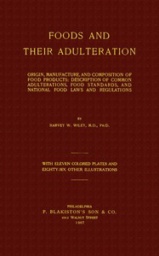

Foods and Their Adulteration (1907)
by Harvey Washington Wiley


The first step in the refining of a crude cottonseed oil is to have it stored in large and deep tanks where it remains at rest for a proper length of time. During this period of rest the heavy mechanical impurities and water settle to the bottom of the tank and are typically known as "foots." The oily portions of these fats are used in the manufacture of soap and for other technical purposes. The tanks may be connected with steam jackets in order to keep the oil at a proper temperature. During the process of deposition the oil is also treated with an alkali to neutralize the free acid which it contains. The precipitate formed by this process together with the principal part of the soaps produced are recovered with the "foots." A solution of caustic or carbonated soda is one generally employed in this process of refining. If the admixture of caustic soda occurs at the time of filling the tank, the contents are kept well agitated for a sufficient length of time to secure an intimate mixture of the oil with the lye. Usually the deposition of the solid matter is accomplished in from two to three days. The supernatant oil is of a light yellow color, but not sufficiently pure to admit of being used for edible purposes. This yellow oil is treated again in a similar manner and allowed to settle a second time, or it is mixed with some substance which will facilitate the operation, and subjected to filtration by means of which a perfectly bright oil is secured. If, during this process, the oil has never been chilled so as to separate a part of its stearin, it is called summer oil, as an indication that it only remains clear during the hot weather. Oils intended for winter use are chilled before finally being put into packages, and the stearin which is separated at this low temperature is removed by filtration. The residual oil which is capable of remaining liquid at a low temperature by reason of the removal of a portion of its stearin, as above described, is known in the trade as winter oil. In this process of filtration fuller's earth is frequently employed, which not only promotes the filtration but also absorbs and retains a large part of the color of the oil, which thus treated is almost colorless. Where cottonseed oil is used for mixing with lard it is highly important that it be practically free of color. When, however, it is used for mixing with oleomargarine the more yellow it is the more highly prized.🏁
Global Leaderboard
| # | Player | Time | Duration | Accuracy | WPM | pp | |
|---|---|---|---|---|---|---|---|
| 1 | |||||||
| 2 | |||||||
| 3 | |||||||
| 4 | |||||||
| 5 | |||||||
| 6 | |||||||
| 7 | |||||||
| 8 | |||||||
| 9 | |||||||
| 10 |


The first step in the refining of a crude cottonseed oil is to have it stored in large and deep tanks where it remains at rest for a proper length of time. During this period of rest the heavy mechanical impurities and water settle to the bottom of the tank and are typically known as "foots." The oily portions of these fats are used in the manufacture of soap and for other technical purposes. The tanks may be connected with steam jackets in order to keep the oil at a proper temperature. During the process of deposition the oil is also treated with an alkali to neutralize the free acid which it contains. The precipitate formed by this process together with the principal part of the soaps produced are recovered with the "foots." A solution of caustic or carbonated soda is one generally employed in this process of refining. If the admixture of caustic soda occurs at the time of filling the tank, the contents are kept well agitated for a sufficient length of time to secure an intimate mixture of the oil with the lye. Usually the deposition of the solid matter is accomplished in from two to three days. The supernatant oil is of a light yellow color, but not sufficiently pure to admit of being used for edible purposes. This yellow oil is treated again in a similar manner and allowed to settle a second time, or it is mixed with some substance which will facilitate the operation, and subjected to filtration by means of which a perfectly bright oil is secured. If, during this process, the oil has never been chilled so as to separate a part of its stearin, it is called summer oil, as an indication that it only remains clear during the hot weather. Oils intended for winter use are chilled before finally being put into packages, and the stearin which is separated at this low temperature is removed by filtration. The residual oil which is capable of remaining liquid at a low temperature by reason of the removal of a portion of its stearin, as above described, is known in the trade as winter oil. In this process of filtration fuller's earth is frequently employed, which not only promotes the filtration but also absorbs and retains a large part of the color of the oil, which thus treated is almost colorless. Where cottonseed oil is used for mixing with lard it is highly important that it be practically free of color. When, however, it is used for mixing with oleomargarine the more yellow it is the more highly prized.🏁